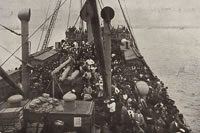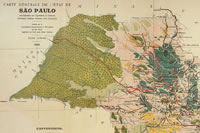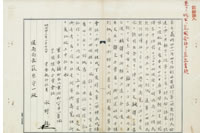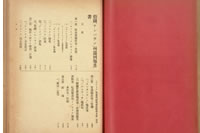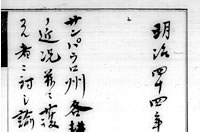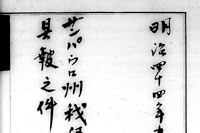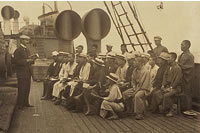Voyage, assigned to plantations and leaving plantations
Voyage on board the ship Kasato-maru
The ship Kasato-maru was chartered from the Oriental Steamship Company to ship emigrants. When receiving permission from the Ministry of Foreign Affairs, the Kokoku Shokumin Kaisha (Kokoku Colonization Company) was required to pay an additional 50,000 yen in guarantee deposits, the company, however, could not afford the payment by the agreed upon date, April 10 and postponed the departure to April 12 and then three times. On April 25, with 30,000 yen paid, the company requested a deferment of the payment of the remainder it and was accepted, and the ship Kasato-maru finally set sail from the port of Kobe on April 28. Passing through Singapore and the Cape of Good Hope, the steamship arrived at the port of Santos, in the State of São Paulo on June 18.
Assignment to coffee plantations
From the Port of Santos, the emigrants were taken by train to the City of São Paulo where they stayed in the Immigrant House which was a modern facility, until June 25, and were then sent as agricultural workers (colonos) to six large fields, Dumont (on the Mogiana line), Guatapara (on the Paulista line), Sao Martinho (on the Paulista line), Floresta (Itu station on the Ituense line in the current city of Itu), Canaan (on the Mogiana line) and Sobrado (on the Sorocabana line). "The five interpreters "(Unpei Hirano, Sakae Mini, Motohisa Ono, Junnosuke Kato and Takashi Nihei) and Teijiro Suzuki were separately assigned to each plantation as an interpreter. It seems that a life in these plantations was a tremendous disappointment for the emigrants from the very beginning. Houses allotted to the emigrants were nothing more than small shacks, without not only furniture but floorings and the emigrants were forced to sleep on earthen floors for the present. In the coffee plantations, the emigrants were forced to live a life restricted by the times of day that bells or horns signaled and the work was supervised by a foreman, some of whom still treated them in the same manner as slaves were treated 20 years ago when slavery was legal.
Disturbances in plantations
Since the year 1908 was a poor coffee harvest year and in addition more than half the harvest season had passed when the emigrants arrived late and they were inexperienced in the work, they picked coffee in small quantities and their earnings were small. In the Dumont plantation where conditions were the worst among the plantations due to aging plants and extremely poor harvests, a family of three earned only 15 mil reis, approximately 90 sen (=0.9 yen) in a day and commodity prices were high, consequently, the emigrants could not build a savings and even afford their daily living expenses. They were already seriously discontented at the beginning of July immediately after they arrived at the plantation, and their deepened discontents at last caused a disturbance there, where Shuhei Uetsuka and Ryo Mizuno of the Kokoku Colonization Company and Legation Interpreter, Arajiro Miura rushed to intervene in August. It is said that emigrants complained to Uetsuka, "We could only live from hand to mouth if we stayed in Japan. We would not have saddened our parents and have come all the way to Brazil. Although we have worked like a slave, we have made only eight hundred reis per day (40 sen). We will not intend to work for such wages at all". Miura took all of the emigrants back to the Immigrant House in São Paulo, and sent single emigrants of them to a construction site on the Sorocabana railroad and reassigned family emigrants to different coffee plantations.
In September, a strike occurred in the Sao Martinho plantation, where Miura and Mizuno rushed to intervene again and removed 20 unyielding emigrants from the plantation. At that time disturbances occurred also in all the other plantations except the Guatapara plantation. Emigrants’ running away in the night frequently happened in all the plantations.
| Note: | 1 mil reis = 1,000 reis = 60 sen (=0.6 yen) (in 1909) or 70 sen (=0.7 yen)(in 1911) |
|---|
Destinations of emigrants who left plantations
Very few of the first set of emigrants had settled in the plantations. Zoji Amarithe, Legation Interpreter, inspected the plantations from December 15, 1908 to January 7, 1909 and submitted a report in order for the Minister to decide whether emigration should continue the next year or not. According to this report, only 359 emigrants still stayed in the six plantations they were originally assigned to (439 emigrants, including those who were reassigned to other plantations and stayed there). Even after the emigrants became accustomed to the field work and their income gradually increased, some of them left plantations when they heard about a better paying job elsewhere. The number dropped to 239 (including those who were reassigned) when Ryoji Noda, Legation Interpreter, inspected from September to October 1909. Among those who left plantations, approximately 102 persons were in São Paulo City (61 worked as domestic servants, 12 as carpenters, 6 as cooks), 110 were in Santos City (all of the men except for 12 men became baggage handlers), 120 became railroad construction workers, 38 went to Rio de Janeiro and Minas Gerais and approximately 160 migrated to Argentina.
-
Articles in newspapers / magazines
-
 Transportation of emigrants by Nippon Yusen
Transportation of emigrants by Nippon Yusen -
 São Paulo City Immigrant House dormitory
São Paulo City Immigrant House dormitory -
 Map of the State of São Paulo
Map of the State of São Paulo -
Books
-
Articles in newspapers / magazines
-
 Report on the first set of emigrants by the Kokoku Colonization Company
Report on the first set of emigrants by the Kokoku Colonization Company
The second set of emigrants on board the ship Ryojun-maru
Conclusion of the agreement for the second set of emigrants
On November 25, 1908, Ryo Mizuno of the Kokaku Shokumin Kaisha (Kokoku Colonization Company) concluded the modified agreement with the São Paulo State government to bring less than 1,300 migrants the next year. Since the report by Amari, Legislation Interpreter said that the 439 emigrants who stayed in the plantations had no particular complaints and were generally in a good situation, the Ministry of Foreign Affairs permitted the Kokoku Colonization Company to ship a new set of emigrants, if the company had sufficient funds and preparations, provided the problems that occurred with the first set of emigrants had been solved, namely:
- Emigrants should be recruited among those who were accustomed to farm work.
- The agreement should explicitly limit the family structure to a family consisting of actual family members.
- No money should be collected from emigrants on deposit or any other pretext.
- Earnings should not be exaggerated when recruiting.
- The first set of emigrants in 1909 should arrive in mid-April or by the end of May at the latest.
- Those who were able to communicate in Portuguese or Spanish and suitable for a supervisor of emigrants should be assigned interpreters.
The reason why Paragraph 3 was inserted was that emigrants deposited money with the Kokoku Colonization Company before departure but the company could not repay the money due to fund shortage and that it had become a problem.
Transfer of business to the Takemura Colonization Commercial House
But the Kokoku Shokumin Kaisha (Kokoku Colonization Company) was unable to wipe out fund shortage and Minister Uchida proposed to the Ministry that the company should enter into partnership with another company or transfer the contract. Left with nowhere else to turn, the Kokoku Colonization Company was forced to transfer the business to wealthy Yoemon Takemura (the Takemura Shokumin Shokan (Takemura Colonization Commercial House)), and Ryo Mizuno and Shuhei Uetsuka also transferred to Takemura Colonization Commercial House. The shipment of the second set of emigrants was carried out by the Takemura Colonization Commercial House, and 906 emigrants (in addition, another 3 free emigrants) set sail from Kobe on May 4, 1910 and arrived at the port of Santos on June 28. The emigrants were assigned to 17 plantations and although in some of the plantations, such as the Jatahy plantation, disturbances occurred, the rate of emigrants' settlement in plantations had been improved, and in March 1911, 681 emigrants stayed in the plantations they had originally contracted with.
Discontinuation of emigrant shipment
On November 12, 1910, the Toyo Imin Gaisha (Oriental Emigration Company) concluded an agreement with the São Paulo Government for the shipment of emigrants, separate from the agreement concluded between the Government and the Takemura Colonization Commercial House. The Oriental Emigration Company had tried unsuccessfully to ship a set of emigrants to Brazil in 1897 but was prevented by the Tosa-maru incident and was now attempting to make a comeback. Since Tadao Kamiya, a manager of the company, was dispatched to Brazil in 1908, he had negotiated with the State Government and finally reached an agreement with it. Thereby both the Takemura Colonization Commercial House and the Toyo Emigration Company would ship emigrants to Brazil at the same time from 1912 onwards.
But in 1914, on grounds of the downturn of the state economy and the low rate of Japanese immigrants’ settlement in plantations, the State of São Paulo terminated the agreements on attracting immigrants and stopped providing grants for travel costs of. As a result, emigration to Brazil was unavoidably discontinued.
-
Articles in newspapers / magazines
-
 Report on the inspection tour in April 1911
Report on the inspection tour in April 1911 -
 Report on emigrants’ situation in July 1911
Report on emigrants’ situation in July 1911 -
 Situations of Japanese immigrants in the Guatapara plantation
Situations of Japanese immigrants in the Guatapara plantation -
 Immigrants soon became accustomed to unfamiliar work
Immigrants soon became accustomed to unfamiliar work -
 Portuguese language classes (on board the ship Shiatoru-maru) on June 30, 1917
Portuguese language classes (on board the ship Shiatoru-maru) on June 30, 1917

